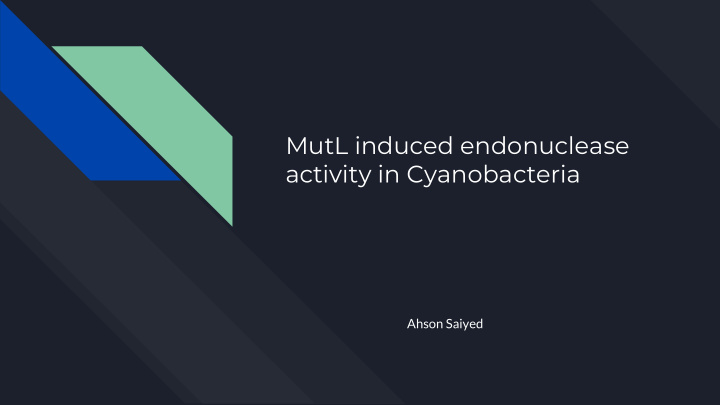



MutL induced endonuclease activity in Cyanobacteria Ahson Saiyed
Energy Crisis Fossil fuels consumption ● Toxic emissions ● Climate Change ● Public Health Risk ●
Cyanobacteria as a platform for biofuel production Photosynthetic ● Ubiquitous and robust ● Microbial factories ● Limitation = Genetic Stability ●
The role of repetitive sequences... HIP1- octameric palindrome (5'-GCGATCGC-3') ● Why so frequent/conserved? ● Functional Role? ● Proposed ideas….. ●
MMR in E.Coli vs Cyanobacteria - MutH does not exist in Cyanobacteria - Role of MutL and MutS remains unknown Elhai et. al 2015
How to measure MutL endonuclease activity ● MutL gene plasmid isolated from Cyanobacterial strain and replicated using PCR
How to measure MutL endonuclease activity Purification of MutL plasmid to yield homogenous MutL protein
How to measure MutL endonuclease activity A similar process would be done with potential ● mismatch and hemimethylated GMeC/CG sites (PCR + Purification) Use electrophoresis to measure the amount of single ● stranded breaks Different rates of hydrolysis Control by other restriction enzymes
Predicted Results & Limitations MutL endonuclease activity will be present in Cyanobacteria ● Hydrolysis may not be convincing without the use of cations to increases enzymatic ● activity
Postulated G Me C-dependent mismatch repair system Theory for gain and loss of HIP1 ● Association with MTases ● Theory could be supported by ● endonuclease MutL activity at the hemimethylated GMeC/CG sites Elhai et. al 2015
References T.A. Boden, G. Marland, and R.J. Andres. 2017. Global, Regional, and National Fossil-Fuel CO2 Emissions. Available at: doi:10.3334/CDIAC/00001_V2010 https://www.ncbi.nlm.nih.gov/pmc/articles/PMC5289912/ 1] Batsalova, Tsvetelina, et al. “Assessment of the Cytotoxicity, Antioxidant Activity and Chemical Composition of Extracts from the Cyanobacterium Fischerella Major Gomont.” Chemosphere , vol. 218, 2019, pp. 93–103., doi:10.1016/j.chemosphere.2018.11.097. [2] Singh, Harinder. “Desiccation and Radiation Stress Tolerance in Cyanobacteria.” Journal of Basic Microbiology , vol. 58, no. 10, 2018, pp. 813–826., doi:10.1002/jobm.201800216. [3]Cassier-Chauvat, Corinne, et al. “Comparative Genomics of DNA Recombination and Repair in Cyanobacteria: Biotechnological Implications.” Frontiers in Microbiology , vol. 7, 2016, doi:10.3389/fmicb.2016.01809. [4] Xu, Minli, et al. “Selection, Periodicity and Potential Function for Highly Iterative Palindrome-1 (HIP1) in Cyanobacterial Genomes.” Nucleic Acids Research , vol. 46, no. 5, 2018, pp. 2265–2278., doi:10.1093/nar/gky075. [5] Monakhova, M. V., et al. “Endonuclease Activity of MutL Protein of the Rhodobacter Sphaeroides Mismatch Repair System.” Biochemistry (Moscow) , vol. 83, no. 3, 2018, pp. 281–293., doi:10.1134/s0006297918030082. [6] Elhai, Jeff. “Highly Iterated Palindromic Sequences (HIPs) and Their Relationship to DNA Methyltransferases.” Life , vol. 5, no. 1, 2015, pp. 921–948., doi:10.3390/life5010921. [8] Wyrzykowski, J., and M. R. Volkert. “The Escherichia Coli Methyl-Directed Mismatch Repair System Repairs Base Pairs Containing Oxidative Lesions.” Journal of Bacteriology , vol. 185, no. 5, 2003, pp. 1701–1704., doi:10.1128/jb.185.5.1701-1704.2003. [9] Duppatla, Viswanadham, et al. “The C-Terminal Domain Is Sufficient for Endonuclease Activity OfNeisseria GonorrhoeaeMutL.” Biochemical Journal , vol. 423, no. 2, 2009, pp. 265–277., doi:10.1042/bj20090626. [10] Winkler, Ines, et al. “Chemical Trapping of the Dynamic MutS-MutL Complex Formed in DNA Mismatch Repair InEscherichia Coli.” Journal of Biological Chemistry , vol. 286, no. 19, 2011, pp. 17326–17337., doi:10.1074/jbc.m110.187641.
Recommend
More recommend